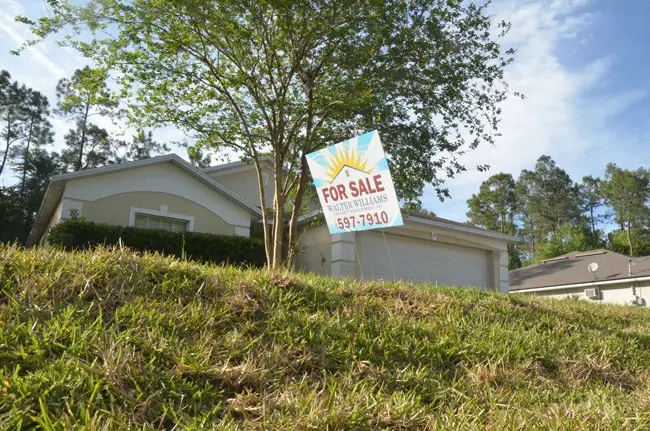
The housing market in Flagler County continues to be mixed, with steady but not spectacular sales, a somewhat lengthening time for a house to sell, but also, for the first time since the Great Recession, a median home price that crossed the $200,000 threshold in March. That’s good for sellers. But it also raises questions about the availability of affordable housing again, as median incomes remain static.
After a relatively strong spring and summer last year, when single-family home sales in Flagler County averaged 239 units a month for the six months through August, average monthly sales have since fallen by 24 percent, to 181 single family houses. In March, 212 units sold, according to figure released by the Flagler County Realtors Association today.
But the average price was $238,394, a figure last seen more than eight years ago, in January 2008, when prices were on the way down, Matthew Wilson, a past president of the association and a Realtor in Flagler Beach, said. A year ago, the average was $191,000. The median price in March was $204,000, up from $160,000 a year ago. In March, 367 properties went on the market, the highest number since June 2015.
“We’ve been inching that way as prices continue to go upward and as inventory continues to go downward,” Wilson said. There are currently just over 1,000 listings in the county, or five months’ supply of single-family houses, down from 5.3 months a year ago, half the supply at the beginning of 2012. Affordable housing meanwhile, Wilson said, “has become a topic of great concern again,” particularly in South Florida and the Gulf region. Recent numbers suggest that it may become so in this region as well.
But, Wilson said, the number of houses selling for cash is still close to 40 percent (78 houses did so last month), suggesting that out of county buyers are moving in and plunking down the money.
That’s been Rick Belhumeur’s experience. A property owner who builds and sells houses in Flagler Beach—where he is also a city commissioner—Belhumeur said he sold two houses for around $330,000 and is building three more for eventual sales, with all that activity happening in the last two years. Both of his buyers were from out of town, retiring locally. There are more reasonable prices in Palm Coast for existing houses that may need a little work, Belhumeur said.
Belhumeur also chairs the Flagler County affordable housing board, but he said the board’s responsibilities don’t intersect directly with the housing market as much as they do with individual low or very low income homeowners who may need help staying in their home or fixing a roof, or who qualify for the sort of aid that can help them transition from a rental to home ownership. Nevertheless, Belhumeur said, even if out-of-state buyers are driving the prices up locally, that means prices end up going for all.
That may be pricing some people out of the market. It may also ex[plain why, Wilson said, there’s been a sudden “surge” of Federal Housing Administration loans and Veterans Administration loans, which help buyers get into their home with less up-front expenses. When they do, the seller has to absorb those up-front costs. As a result, “some sellers will not participate in either program,” Wilson said. “That’s their option.”
Comparatively, the median price in the Daytona Beach area was $175,000 in March, up from $155,000 from a year ago. “Low inventory continues to create hurdles for buyers in the market and we can see that in both the sales numbers and median sales prices,” said Daytona Beach Area Realtor Ron Wysocarski, leader of The Wyse Home Team at Keller-Williams Realty in Port Orange. “During the first quarter of last year, buyers had 2926 active listings for detached single family homes to choose from. This year, buyers had only 2050 listings active in that time range to consider.”
The overall market is stable, Wilson said, with sales on the beach side and in Palm Coast and slower activity on the west side of the county. “I don’t know that there are enough transactions to support the people that we have in the profession right now,” he noted, “but that’s their individual choices.”
Garry Lubi, vice president of Ameris Bank, usually focuses on commercial loans—he was behind the refinancing of major notes for several local governments in the past 18 months—but he notes one important trend: “People are buying the houses for the right reasons, they’re buying to live in, as a long term investment,” Lubi said. That’s different from what he saw 10 years ago, when people were buying just to flip houses.
Lubi says it’s still an affordable environment overall. For people buying houses now—the 60 percent that are not necessarily putting down cash or big down payments—“typically you’re looking at a two-income situation, that helps, plus the interest rate environment is still at all-time lows, that also helps,” Lubi said. “It definitely is a challenge though as prices continue to go up. But it does appear that we still have homes available in that $150,000 to $200,000 range, and in the low-interest rate environment it’s still something that with a good, solid income you can still afford.”
In March, 99 houses sold in the $100,000 to $200,000 range, and some 90 houses sold in the $200,000 to $400,000 range.
Another post-recession high: 90 percent of all sales were “traditional” sales, as opposed to foreclosures or short sales.
The Realtors’ Association’s full report is below.
![]()
Click to access flagler-county-home-sales-2016-march.pdf





























Leave a Reply